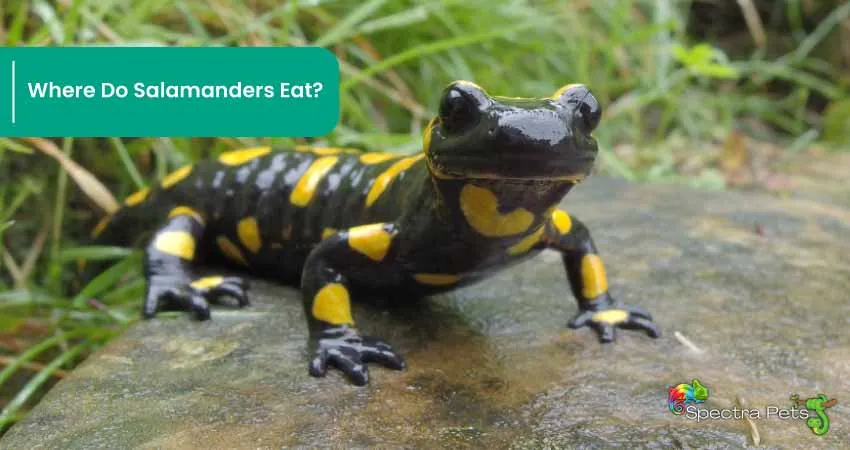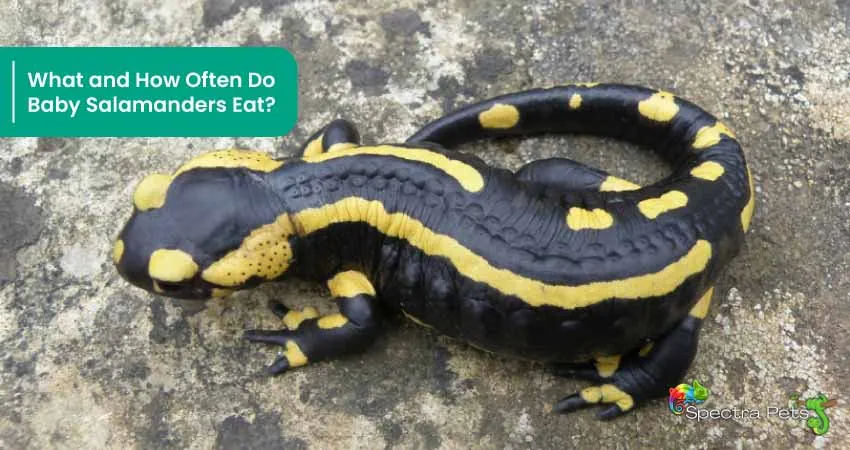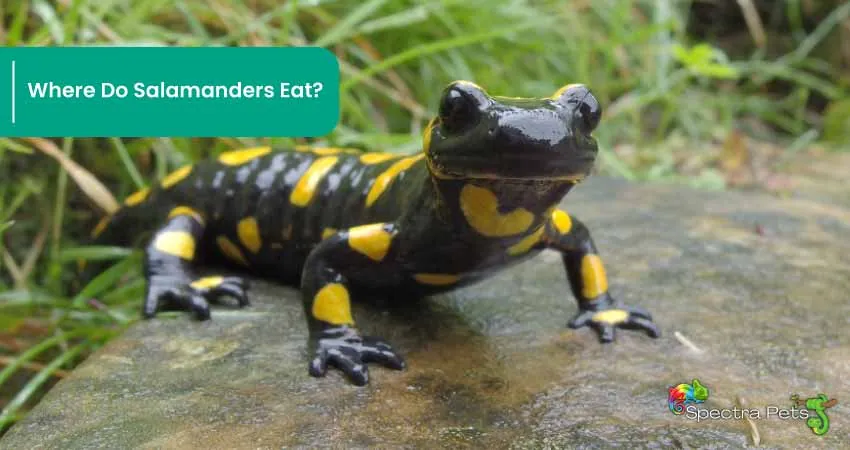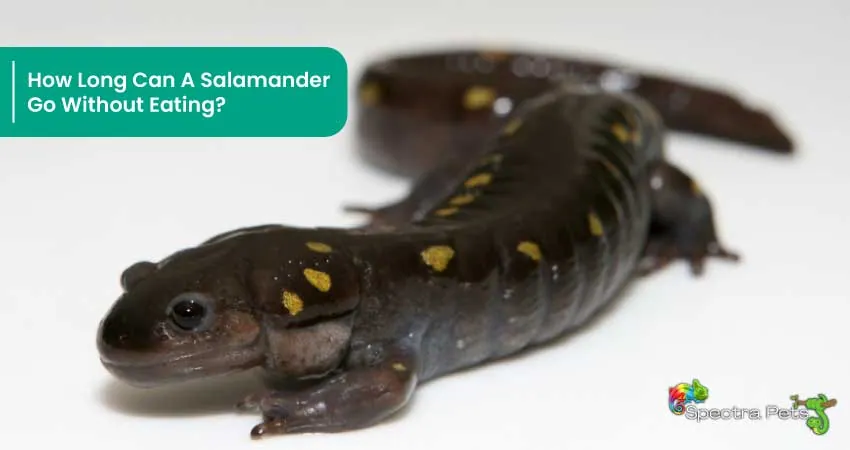Having a thorough understanding of your Salamander’s food habits is crucial if you are raising a Salamander for the first time. There is no doubt that Salamanders eat a wide variety of foods in the wild. But, when you are familiar with the best food types for Salamanders, you can give them far more nutritious food in captivity than they would receive in the wild.
Yes, keeping a salamander properly requires some specific knowledge, including understanding what and how to feed them. Here, in this article, I’ll provide a guide to feeding your salamander and ensuring they are healthy and happy. So, keep scrolling…
What Do Wild Salamanders Eat?

First of all, let us find out what most salamanders feed on in their natural habitats.
Salamanders are carnivorous animals, which means that they rely on a diet of animal protein to survive. The specific diet of a wild Salamander will depend on the species and the availability of prey in its natural habitat. In general, Salamanders will consume any prey that they can capture and fit into their mouths.
Wild salamanders typically eat insects and other small invertebrates. This can include spiders, worms, snails, slugs, and other small arthropods. Some species may also feed on smaller vertebrates, such as worms, small fish, and small amphibians.
Best Food For Salamanders: What Should I Feed My Pet Salamander?
Under captivity, a salamander has access to food that is better in nutritional value than those in the wild, thanks to you! Let’s learn more about some foods that you can feed them:
Live and Frozen Protein-based Food
When it comes to feeding your pet salamander, it’s important to offer a varied diet that closely mimics what they would eat in the wild. This can include live or frozen insects, such as crickets, mealworms, and waxworms. You can also offer frozen or freeze-dried invertebrates, such as bloodworms, brine shrimp, and earthworms.
It’s important to avoid feeding your salamander insects that have been treated with pesticides or other chemicals, as this can be harmful to their health.
Vegetables
In addition to insects, Salamanders can also benefit from a small amount of vegetables in their diet. Leafy greens, such as lettuce and kale, can provide important nutrients and help to keep your salamander’s digestive system functioning properly. You can also offer small amounts of fruit as an occasional treat.
However, these offerings should be limited to specific salamander species, as not all are able to digest vegetables.
Commercial Foods and Supplements
It’s important to choose a commercial food that is formulated specifically for salamanders and meets their nutritional needs. It’s also a good idea to read the label and ingredient list carefully to ensure that the food does not contain any additives or preservatives that may be harmful to your salamander.
Also, it is possible to find a variety of pelleted diets made from different insects that are nutritionally balanced.
In addition to commercial food, there are also a number of supplements available that can help provide your salamander with the nutrients that they need. These can include calcium supplements, which can help to support healthy bone growth and prevent metabolic bone disease, as well as vitamin supplements, which can help to support overall health and immune function.
Use supplements as directed and seek advice from a reputable care manual or a veterinarian to ascertain the particular requirements of your salamander. Overuse of supplements can lead to imbalances in your salamander’s diet and may cause health problems.
Water
Salamanders should also have access to clean, fresh water at all times. You can provide your pet amphibian with a shallow dish filled with water, and you can also mist the enclosure to help keep the air humid.
When and How Often Should I Feed My Salamander?

The frequency and timing of feedings for your salamander will depend on a number of factors, including the species of salamander, its size, and its age. In general, it’s important to offer small, frequent meals rather than large, infrequent ones. Overfeeding can lead to obesity and other health problems, so it’s important to be mindful of the amount of food that you offer.
As a general rule, adult salamanders need to eat every 2-3 days, while Juvenile salamanders eat more frequently. It’s also a good idea to vary the types of food that you offer to ensure that your salamander is getting a balanced diet.
It’s also important to consider the specific nutritional needs of the salamander species that you are caring for. Some species may have higher protein requirements or may need to be fed more frequently than others. It’s a good idea to research the specific needs of your salamander and follow the recommendations of a reputable source, such as a veterinarian or a reputable care guide.
Can I Overfeed My Salamander?

Yes, it is possible to overfeed a salamander. Like all animals, salamanders have specific nutritional needs and require a balanced diet in order to stay healthy. Overfeeding can lead to obesity and other health problems, such as liver disease and heart problems.
These amphibians have small stomachs and should be fed small, frequent meals rather than large, infrequent ones. It’s important to be mindful of the amount of food that you offer and to follow the recommendations of a reputable source, such as a veterinarian or a reputable care guide, for the specific needs of your salamander species.
What and How Often Do Baby Salamanders Eat?

Baby salamanders, also known as larvae or tadpoles, typically have a different diet than adult salamanders. In the wild, baby salamanders will typically feed on algae, small invertebrates, and other organic matter that is found in their aquatic environment.
When caring for baby salamanders in captivity, it’s important to provide a diet that closely mimics what they would eat in the wild. Generally, you must feed them more frequently than adults, as they have a high metabolism in their larval stage.
As baby salamanders grow and transition to the adult stage, they will typically switch to a diet that is more similar to that of adult salamanders.
Where Do Salamanders Eat?

Salamanders are found in a variety of environments around the world and can be found in both aquatic and terrestrial habitats. The specific location where a salamander will eat will depend on the species and the availability of food in its natural habitat.
In captivity, salamanders will feed in a variety of locations, such as in a terrarium or aquarium. It’s important to provide a clean, appropriate enclosure for your salamander and to offer a varied diet that meets its nutritional needs. It’s also important to provide clean, fresh water at all times.
How Long Can A Salamander Go Without Eating?

Salamanders are carnivorous animals that typically need to eat regularly in order to survive. However, some species of salamanders are able to go for extended periods of time without food, especially during times when food is scarce or when they are in a state of torpor (a period of reduced activity and metabolism).
The specific length of time that a salamander can go without eating will depend on the species and its size, as well as environmental conditions such as temperature and humidity.
Frankly speaking, you must feed your pet salamander at least once a week. There’s no way of cheating from this!
Frequently Asked Questions(FAQs)
What Human Food Can Salamanders Eat?
If you are considering feeding your salamander human foods as a treat, it is important to be very selective about what you offer. Some options that may be appropriate for salamanders in small quantities include small pieces of cooked meat (such as chicken or fish), boiled eggs, and small amounts of calcium-rich vegetables such as broccoli or kale.
Remember that these should only be offered as occasional treats and should not make up a significant portion of the salamander’s diet.
Do Salamanders Eat Fruits and Vegetables?
While they are not able to digest plant matter, some species of salamanders may occasionally consume small amounts of fruit or vegetables if they are present in their environment. However, these types of foods should not be the primary source of nutrition for a salamander, as they are not able to provide the necessary nutrients that the animal needs to survive.
Can I Feed A Salamander Fish Food?
I would not recommend feeding salamanders fish food as a primary source of nutrition, as these products are not formulated to meet the specific dietary needs of these amphibians. While some species of salamanders may occasionally consume small amounts of fish or other types of meat as a treat, these should not make up a significant portion of their diet.
How Many Crickets Should A Salamander Eat?
It is a good idea to offer your salamander as many prey items as it will consume in a single feeding, up to a maximum of around 10-15 crickets per day for an adult salamander.
Will Salamanders Eat Ants?
Some salamanders do feed on ants in the wild. But you shouldn’t do this at home, as ants are not nutritious enough to keep your salamanders well-nourished.
Finishing Up
By following these guidelines and providing a varied diet, you can help ensure that your salamander stays healthy and happy in captivity. Remember to always research the specific needs of the species of salamander you are caring for, as different species may have slightly different dietary requirements. The right care and feeding will ensure that your salamanders will be rewarding and enjoyable pets for years to come.
Hopefully, this feeding guide will help you decide what is the best food for your Salamander and learn more about their food habits. Please feel free to contact us if you have any further questions. Wishing you and your little buddy a nice day!

